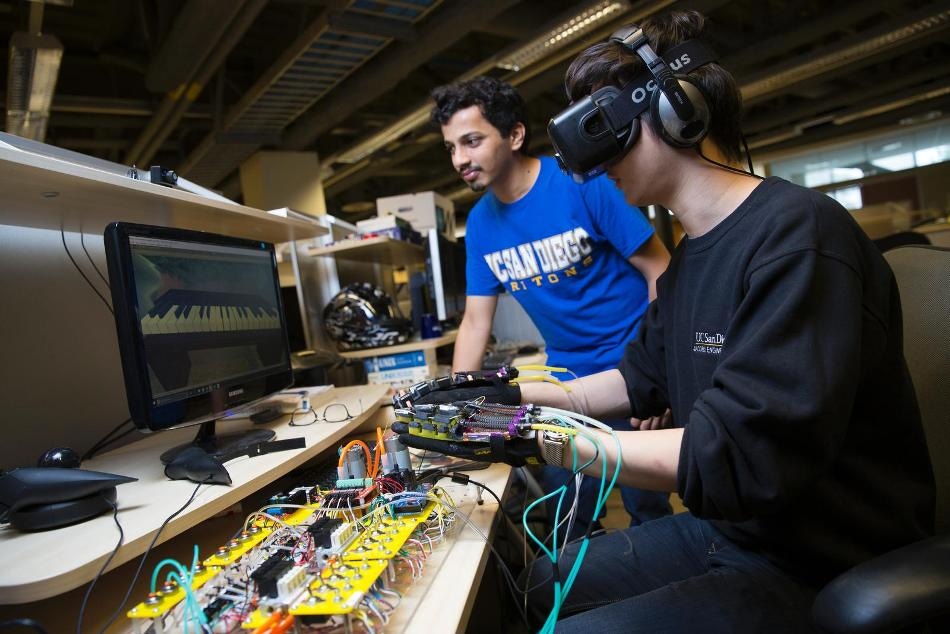May 31 2017
UC San Diego Engineers are employing soft robotics technology to create light, flexible gloves that enable users feel tactile feedback when they interact with virtual reality situations. The Engineers used the gloves to convincingly mimic the tactile feeling of playing a virtual piano keyboard.
 A glove powered by soft robotics is allowing these Ph.D. students to play piano in VR. (credit: UC San Diego)
A glove powered by soft robotics is allowing these Ph.D. students to play piano in VR. (credit: UC San Diego)
The Researchers recently reported their research, which is still at the prototype phase, at the Electronic Imaging, Engineering Reality for Virtual Reality (VR) conference in Burlingame, California.
At present, VR user interfaces comprise of remote-like devices that vibrate when a user touches a virtual object or surface.
They’re not realistic. You can’t touch anything, or feel resistance when you’re pushing a button. By contrast, we are trying to make the user feel like they’re in the actual environment from a tactile point of view.
Jurgen Schulze, Researcher, Qualcomm Institute, UC San Diego
Other Research teams and industries have also created gloves as VR interfaces. But these are bulky and formed using heavy materials, such as metal. The UC San Diego glove has a soft exoskeleton equipped with soft robotic muscles that make it easier to use and much lighter.
This is a first prototype but it is surprisingly effective.
Michael Tolley, Mechanical Engineering Professor, The Jacobs School of Engineering, UC San Diego
One main element in the design of the glove is a type of soft robotic component known as a McKibben muscle, fundamentally latex chambers covered with braided fibers. The muscles react like springs to apply force when the user wriggles their fingers. The board controls the muscles by inflating and deflating them. The system has three key parts: a Leap Motion sensor that detects the movement and position of the user’s hands; a custom fluidic control board that manages the gloves' movements; and soft robotic components in the glove that separately inflate or deflate to simulate the forces that the user would experience in the VR environment. The system networks with a computer that displays a virtual piano keyboard with trees and a river in the background.
The Researchers printed a 3D mold to create soft exoskeleton of the gloves. Making the devices easier to produce and appropriate for mass production, they said. The team used silicone rubber for the exoskeleton, with Velcro straps fixed at the joints.
The Researchers did an informal pilot study of fifteen users, which included two VR Interface Experts. Each of them tried the demo and played the piano in VR. They all agreed that the gloves improved the immersive experience. They described it as, “Mesmerizing,” and, “Amazing.”
The Engineering Research team aims now to make the glove less bulky, cheaper and more portable. They also would like to sidestep the Leap Motion device completely to make system more compact.
Our final goal is to create a device that provides a richer experience in VR. But you could imagine it being used for surgery and video games, among other applications.
Michael Tolley, Mechanical Engineering Professor, The Jacobs School of Engineering, UC San Diego
A glove powered by soft robotics to interact with virtual reality environments